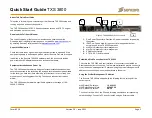
PART THREE - OPERATION
SECTION 4 - TRANSMITTER CALIBRATION
Rev. 0-201
PRO-series Model C3 Conductivity Transmitter
49
S
ECTION
4
4.1 Important Information
☞
☞
Each contacting conductivity sensor has a unique zero point
and span. Consequently,
always zero the sensor when
calibrating it the first time
(Section 4.2). Zeroing provides
the best possible measuring accuracy. Then calibrate for
sensor span using the recommended DRY-CAL method
(Section 4.3) or the traditional, wet 1-POINT SAMPLE
method (Section 4.4).
Calibration Tip!
Conductivity measurement is greatly
affected by small changes in temperature. To measure
conductivity and temperature more accurately, GLI highly
recommends using the DRY-CAL method to calibrate
sensor span. (This is actually a normal part of configur-
ing the sensor characteristics during initial startup.)
DRY-CAL
eliminates the need for conductivity refer-
ence solutions.
It also automatically sets the transmitter
measuring range to match the inherent range of the sen-
sor’s cell constant.
Furthermore, DRY-CAL eliminates
the need to periodically re-calibrate!
The only re-
quirement, depending on the application, may be
periodic cleaning of the sensor. Only when the sensor is
replaced is a new DRY-CAL calibration necessary.
In addition to zeroing and calibrating for sensor span, you
can also calibrate the analog output loop. Refer to Section
4.5 for details.
NOTE:
When the passcode feature is enabled (Section
3.5), you must successfully enter the passcode
before attempting to calibrate the transmitter.
Also, an in-progress calibration can always be
aborted by pressing the ESC key.
After the
“ABORT: YES?” screen appears, do one of the fol-
lowing:
•
Press
ENTER key
to abort. After the “CONFIRM
ACTIVE?” screen appears, press
ENTER key
to
return the analog output to its active state
(MEASURE screen appears).
•
Press
×
×
or
Ø
Ø
key
to choose “ABORT: NO?”
screen and press
ENTER key
to continue cali-
bration.
TRANSMITTER CALIBRATION
















































